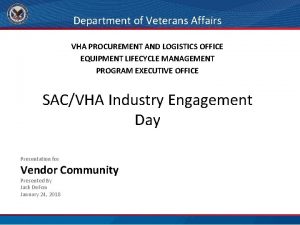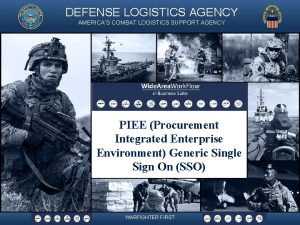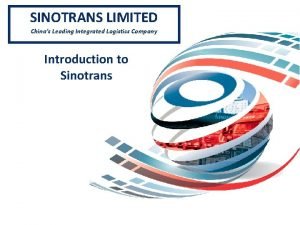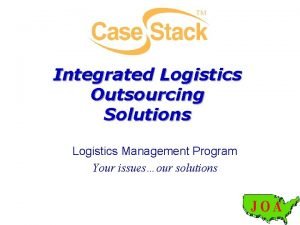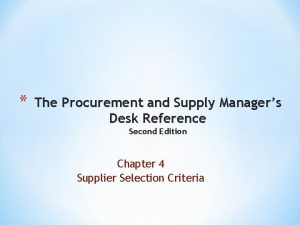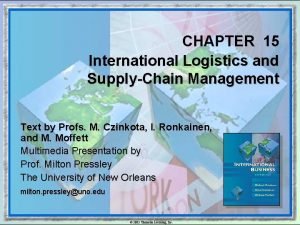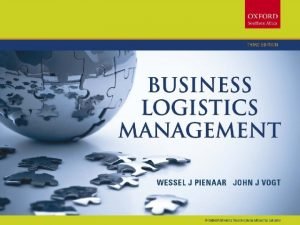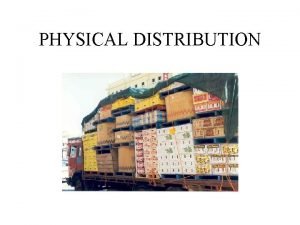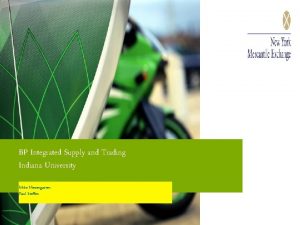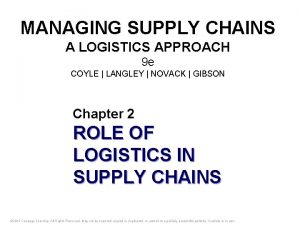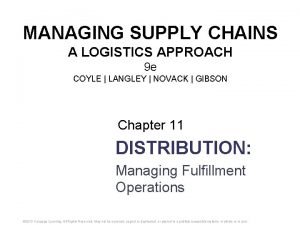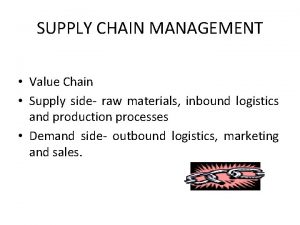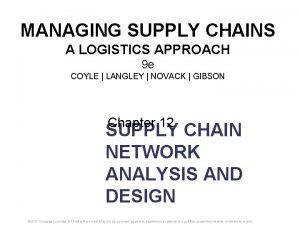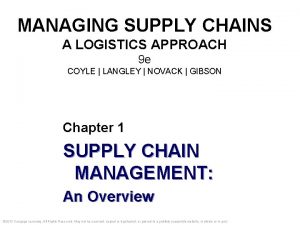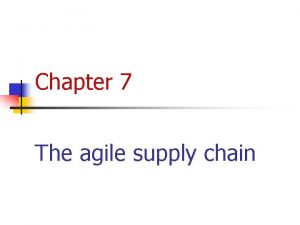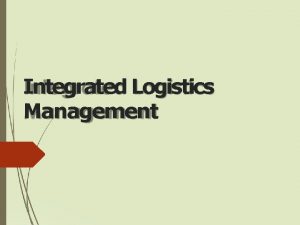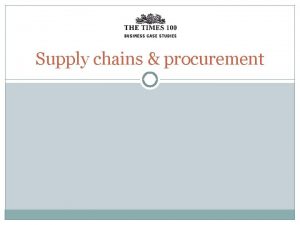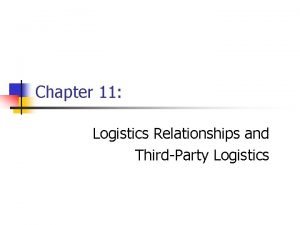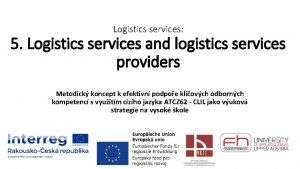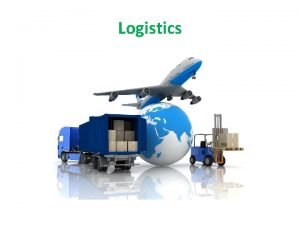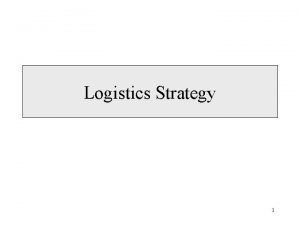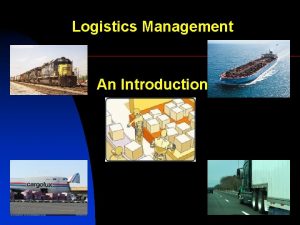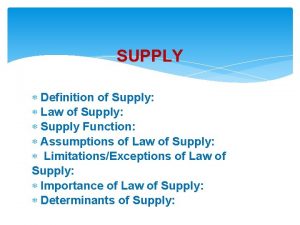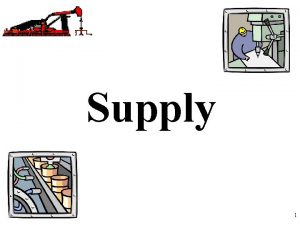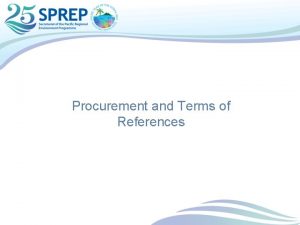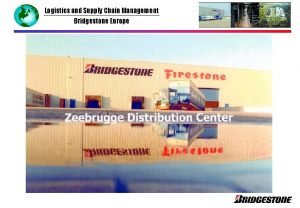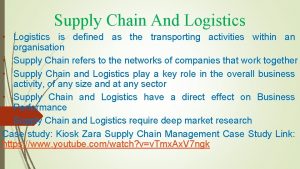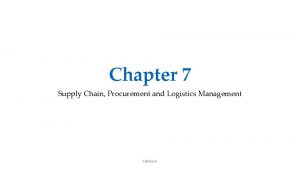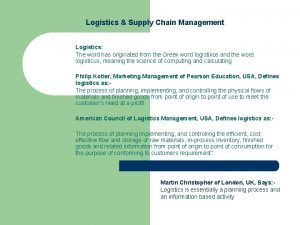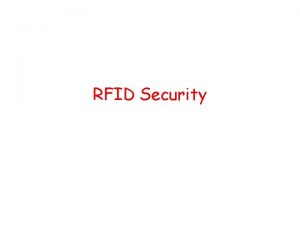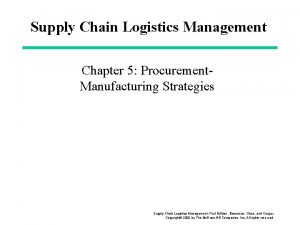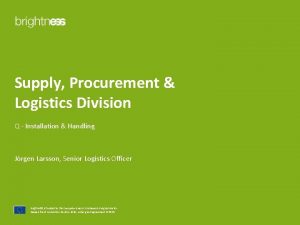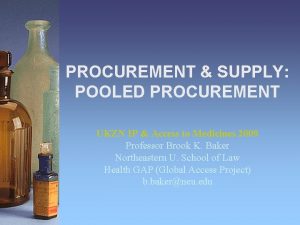Procurement Lecture 2 Integrated logistics and the supply




































- Slides: 36

Procurement- Lecture 2 Integrated logistics and the supply chain ABDIKARIM MOHAIDIN AHMED muhudiin@gmail. com

INTRODUCTION • In this chapter, the emphasis is on the need to integrate the various distribution and logistics components into a complete working structure that enables the overall system to run at the optimum. • the concept of 'total logistics' is described, and the importance of recognizing the opportunities for appropriate trade-offs is discussed. Concepts of Logistics and Distribution 2

THE TOTAL LOGISTICS CONCEPT • The total logistics concept (TLC) aims to treat the many different elements that come under the broad category of distribution and logistics as one single integrated system. • It is a recognition that the interrelationships between different elements, for example delivery transport and storage, need to be considered within the context of the broader supply chain. Concepts of Logistics and Distribution 3

THE TOTAL LOGISTICS CONCEPT Cont… • The total system should be considered and not just an individual element or subsystem in isolation. Concepts of Logistics and Distribution 4

Different levels of trade-offs • Four different levels of trade-off have been identified: 1. Within distribution components: those trade-offs that occur within single functions. – One example would be the decision to use random storage locations compared to fixed storage locations in a depot. Concepts of Logistics and Distribution 5

Different levels of trade-offs Cont. . – The first of these provides better storage utilization but is more difficult for picking; the second is easier for picking but does not provide such good storage utilization. 2. Between distribution components: trade-offs between the different elements in distribution. – A company might increase the strength and thus the cost of packaging but find greater savings through improvements in the warehousing and storage of the product Concepts of Logistics and Distribution 6

Different levels of trade-offs Cont. . 3. Between company functions: there a number of areas of interface between company functions where trade-offs can be made. – An example is the trade-off between optimizing production run lengths and the associated warehousing costs of storing the finished product. – Long production runs produce lower unit costs (and thus more cost-effective production) but mean that more product must be stored for a longer period (which is less cost-effective for warehousing). Concepts of Logistics and Distribution 7

Different levels of trade-offs Cont. . 4. Between the company and external organizations: where a trade-off may be beneficial for two companies that are associated with each other. – For example, a change from a manufacturer's products being delivered direct to a retailer‘s stores to delivery via the retailer's distribution depot network might lead to mutual savings for the two companies. Concepts of Logistics and Distribution 8

Different levels of trade-offs Cont. . – These types of trade-offs are thus at the heart of the total logistics concept. For the planning of distribution and logistics, it is important to take this overall view of a logistics system and its costs. – The other side of the equation is, of course, the need to provide the service level that is required by the customer. This balance of total logistics cost and customer service level is essential to successful logistics. Concepts of Logistics and Distribution 9

Figure 2. 1 Some potential trade-offs in logistics, showing how different company functions might be affected Concepts of Logistics and Distribution 10

PLANNING FOR DISTRIBUTION AND LOGISTICS • In order to ensure that the concept of total logistics is put into practice and that suitable trade-offs are achieved, it is essential that a positive planning approach is adopted. • Planning should be undertaken according to a certain hierarchy that reflects different planning time horizons. These are generally classified as strategic, tactical and operational. Concepts of Logistics and Distribution 11

PLANNING FOR DISTRIBUTION AND LOGISTICS Cont… Concepts of Logistics and Distribution 12

Concepts of Logistics and Distribution 13

Concepts of Logistics and Distribution 14

Concepts of Logistics and Distribution 15

THE FINANCIAL IMPACT OF LOGISTICS • For many companies, a key measure of success is the return on investment (ROI): the ratio between the net profit and the capital employed in the business. For improved business performance, this ratio needs to be shifted to increase profits and reduce capital employed. • There are many different ways in which logistics can have both a positive and a negative impact on the ROI. These are outlined in Figure 2. 6. Concepts of Logistics and Distribution 16

Concepts of Logistics and Distribution 17

GLOBALIZATION AND INTEGRATION • One area of significant change in recent years has been the increase in the number of companies operating in the global marketplace. • This necessitates a broader perspective than when operating as an international company. • companies may have a presence across a wide geographic area, this is supported on a local or regional basis through local or regional sourcing, manufacturing, storage and distribution. Concepts of Logistics and Distribution 18

GLOBALIZATION AND INTEGRATION Cont… • The company is truly global, with a structure and policy that represent a global business. Typical attributes will include: – global branding; – global sourcing; – global production; – centralization of inventories; – centralization of information; Concepts of Logistics and Distribution 19

GLOBALIZATION AND INTEGRATION Cont… • The major logistics implications of globalization are: – extended supply lead times; – extended and unreliable transit times; – multiple break-bulk and consolidation options; – multiple freight mode and cost options; – production postponement with local added value. Concepts of Logistics and Distribution 20

INTEGRATED SYSTEMS • To support the need to develop more integrated operations there have been a number of recent developments in logistics and distribution systems that have the concept of total logistics as their basis. • The major reason for this explosion of new ideas is twofold: – The first is the realization of the importance, cost and complexity of logistics. Concepts of Logistics and Distribution 21

INTEGRATED SYSTEMS Cont. . – The second is the progress made in the field of information technology, which has enabled the development of sophisticated information systems to support and enhance the planning and management of logistics operations, whereby very detailed data collection and analysis can be undertaken that was previously impossible. Concepts of Logistics and Distribution 22

INTEGRATED SYSTEMS Cont. . • Direct product profitability (DPP): DPP is a technique of allocating all of the appropriate costs and allowances to a given product. All distribution costs (storage, transport, etc) are therefore assigned to a specific product rather than taking an average over a whole product range. Concepts of Logistics and Distribution 23

INTEGRATED SYSTEMS Cont. . • In this way, areas of inefficiency throughout the whole logistics operation can be identified. DPP techniques can identify the costs of specific products to individual customers and so provide invaluable information for effective marketing strategies. Concepts of Logistics and Distribution 24

INTEGRATED SYSTEMS Cont. . • Materials requirements planning (MRP) and distribution requirements planning (DRP): MRP/DRP systems have been developed as sophisticated, computerized planning tools that aim to make the necessary materials or inventory available when needed. Concepts of Logistics and Distribution 25

INTEGRATED SYSTEMS Cont. . • DRP systems operate by breaking down the flow of material from the source of supply through the distribution network of depots and transportation modes. • Integrated systems of this nature require sophisticated, computerized information systems as their basis. • The benefits of an effective system can be readily seen in terms of reduced freight, storage and inventory holding costs and improved customer service. Concepts of Logistics and Distribution 26

INTEGRATED SYSTEMS Cont. . • Just-in-time (JIT): The overall concept of JIT is to provide a production system that eliminates all activities that neither add value to the final product nor allow for the continuous flow of material – in simple terms, that eliminates the costly and wasteful elements within a production process. Concepts of Logistics and Distribution 27

INTEGRATED SYSTEMS Cont. . • The objectives of JIT are vitally linked to distribution and logistics, including as they do: – the production of goods the customer wants; – the production of goods when the customer wants them; – the production of perfect-quality goods; – the elimination of waste (labor, inventory, movement, space, etc). Concepts of Logistics and Distribution 28

COMPETITIVE ADVANTAGE THROUGH LOGISTICS • Although there is, of course, a cost associated with the movement and storage of goods, it is now recognized that distribution and logistics also provide a very positive contribution to the value of a product. • This is because logistics operations provide the means by which the product can reach the customer or end user in the appropriate condition and required location. Concepts of Logistics and Distribution 29

COMPETITIVE ADVANTAGE THROUGH LOGISTICS Cont… • It is therefore possible for companies to compete on the basis of providing a product either at the lowest possible cost (so that the customer will buy it because it is the least expensive) or at the highest possible value to the customer (eg if it is exactly where and how the customer wants it). Concepts of Logistics and Distribution 30

Concepts of Logistics and Distribution 31

LOGISTICS AND SUPPLY CHAIN MANAGEMENT • The term 'supply chain management' is now commonly used. • This is an extension of the ideas concerning the integrated nature of logistics. • The total logistics concept advocates the benefits of viewing the various elements of logistics as an integrated whole. Concepts of Logistics and Distribution 32

LOGISTICS AND SUPPLY CHAIN MANAGEMENT Cont… • There are four distinct differences claimed for supply chain management over the more classic view of logistics: 1. The supply chain is viewed as a single entity rather than a series of fragmented elements such as procurement, manufacturing, distribution, etc. – The real change is that both the suppliers and the end users are included in the planning process. Concepts of Logistics and Distribution 33

LOGISTICS AND SUPPLY CHAIN MANAGEMENT Cont… 2. Supply chain management is very much a strategic planning process, with a particular emphasis on strategic decision making rather than on the operational systems. 3. Supply chain management provides for a very different approach to dealing with inventory. 4. Central to the success of effective supply chain management is the use of integrated information systems. Concepts of Logistics and Distribution 34

LOGISTICS AND SUPPLY CHAIN MANAGEMENT Cont… Concepts of Logistics and Distribution 35

SUMMARY • The realization of the need for the effective planning and control of distribution has led to the development of several new approaches towards integrated systems. • a number of recent developments in logistics thinking have been put forward, including the globalization of companies, integrated planning systems, the use of logistics to help create competitive advantage and the concept of supply chain management. Concepts of Logistics and Distribution 36
 Vha procurement and logistics office
Vha procurement and logistics office Project procurement management lecture notes
Project procurement management lecture notes Procurement integrated enterprise environment
Procurement integrated enterprise environment Integrated logistics management
Integrated logistics management Tyler godoff
Tyler godoff Integrated logistics management
Integrated logistics management The procurement and supply manager's desk reference
The procurement and supply manager's desk reference Difference between logistics and supply chain
Difference between logistics and supply chain What is crm in supply chain management
What is crm in supply chain management International logistics and supply chain outsourcing
International logistics and supply chain outsourcing Ford cmms
Ford cmms Global logistics and supply chain management
Global logistics and supply chain management Supply chain strategic planning
Supply chain strategic planning Logistics and supply chain management
Logistics and supply chain management 01:640:244 lecture notes - lecture 15: plat, idah, farad
01:640:244 lecture notes - lecture 15: plat, idah, farad Bp integrated supply and trading
Bp integrated supply and trading Managing supply chains a logistics approach
Managing supply chains a logistics approach Managing supply chains: a logistics approach
Managing supply chains: a logistics approach Vender vs supplier
Vender vs supplier Managing supply chains a logistics approach
Managing supply chains a logistics approach Managing supply chains a logistics approach
Managing supply chains a logistics approach Switch mode power supply lecture notes
Switch mode power supply lecture notes Agile supply chain framework
Agile supply chain framework Chapter 5 section 1 supply
Chapter 5 section 1 supply Matching supply with demand
Matching supply with demand Ano ang ratio ng elastisidad
Ano ang ratio ng elastisidad Hình ảnh bộ gõ cơ thể búng tay
Hình ảnh bộ gõ cơ thể búng tay Lp html
Lp html Bổ thể
Bổ thể Tỉ lệ cơ thể trẻ em
Tỉ lệ cơ thể trẻ em Gấu đi như thế nào
Gấu đi như thế nào Tư thế worm breton là gì
Tư thế worm breton là gì Chúa yêu trần thế
Chúa yêu trần thế Môn thể thao bắt đầu bằng từ chạy
Môn thể thao bắt đầu bằng từ chạy Thế nào là hệ số cao nhất
Thế nào là hệ số cao nhất Các châu lục và đại dương trên thế giới
Các châu lục và đại dương trên thế giới Công thức tiính động năng
Công thức tiính động năng
